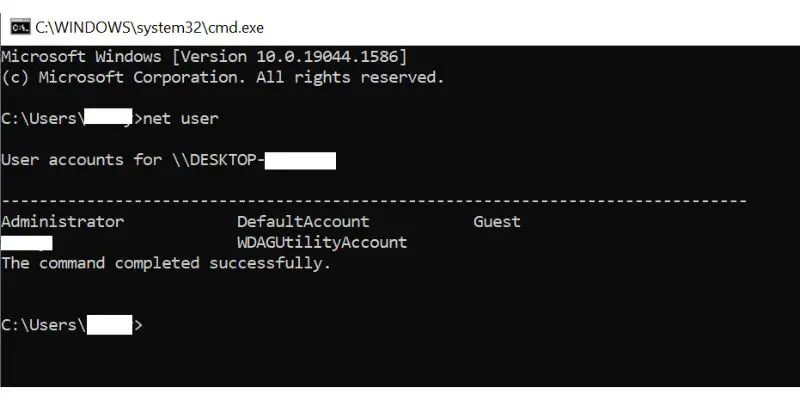Disclaimer: This post may contain affiliate links, meaning we get a small commission if you make a purchase through our links, at no cost to you. For more information, please visit our Disclaimer Page.
If you are using Windows 10, then you may want to know how to be an administrator on your computer.
Being an administrator gives you a lot of control over your system and allows you to make changes that can improve your productivity or security.
In this blog post, we will show you five ways to become an administrator on Windows 10. Let’s get started!
Table of Contents
1. Use the Default Admin Account to Log In
The first way to become an administrator on Windows is to use the built-in Administrator account. This account is created during the installation of Windows and has full control over the system. To use this account, you will need to log in with the username and password that you used during the installation process.
If you are not sure if you have an Administrator account, you can check by going to the Control Panel and looking under the “User Accounts” section. If you see an account with the name “Administrator”, then you have an Administrator account.
To log in with the Administrator account, simply click on the “Administrator” account and enter the password. You will then be logged in with full administrator rights.
Keep in mind that the Administrator account is disabled by default, so you will need to enable it first before you can use it. To do this, go to the Control Panel and click on “User Accounts”. Then, click on “Change account type” and select “Administrator”.
Once you have enabled the Administrator account, you can log in with it by following the steps above.
2. Use an Admin Command Prompt
The second way to become an administrator on Windows is to use the ” Administrator: Command Prompt” shortcut.
This shortcut will open a command prompt with administrator privileges. To use this shortcut, simply press the Windows key + X and then select “Administrator: Command Prompt”/Windows Terminal (Admin)
Once the command prompt has been opened, you can run any commands that you need with administrator privileges. Keep in mind that you will be prompted for the administrator password before the command prompt will open.
If you do not have the “Administrator: Command Prompt” shortcut, you can create it by going to the Start Menu and then selecting “All Programs”. From there, right-click on “Command Prompt” and select “Run as Administrator”.
You can also create a shortcut on the desktop by right-clicking on the desktop and selecting “New -> Shortcut”. In the “Create Shortcut” window, enter “cmd” in the “Location” field and click on the “Next” button.
In the next window, enter “Administrator: Command Prompt” in the “Name” field and click on the “Finish” button.
Once you have created the shortcut, you can double-click on it to open a command prompt with administrator privileges.
Keep in mind that you can also use the “Run as Administrator” option for any program that you want to run with administrator privileges. To do this, simply right-click on the program and select “Run as Administrator”.
You will then be prompted for the administrator password before the program will run.
3. Use an Admin PowerShell Prompt
Open Powershell from cmd (run as admin) and then type the following:
Powershell.exe -Command “Start-Process Powershell -Verb RunAs”
This will open a PowerShell prompt with administrator privileges. You can then run any commands that you need with administrator privileges.
Keep in mind that you will be prompted for the administrator password before the PowerShell prompt will open.
If you do not have PowerShell installed, you can install it by going to the Microsoft website and downloading the latest version.
Once you have installed PowerShell, you can follow the steps above to open a PowerShell prompt with administrator privileges.
4. Gpedit.msc
The fourth way to become an administrator on Windows is to use the “gpedit.msc” tool. This tool allows you to edit the Group Policy settings for your computer. To use this tool, simply hold the Windows key + R and then type “gpedit.msc” into the Run dialog.
Once the “gpedit.msc” window has been opened, you can navigate to the following location:
Computer Configuration -> Administrative Templates -> System -> User Profiles
In the “User Profiles” setting, double-click on the “Limit local account use of administrative privileges” setting and set it to “Disabled”. This will allow you to use your local account with administrator privileges.
Keep in mind that you will need to restart your computer for this setting to take effect.
After you have restarted your computer, you can then use your local account with administrator privileges.
Keep in mind that this method will only work if you have the “gpedit.msc” tool installed on your computer. If you do not have the “gpedit.msc” tool, you can install it by going to the Microsoft website and downloading the latest version.
5. Ask Your IT Department
If you are not able to become an administrator on your own, you can always ask your IT department for help. They will be able to provide you with the information and tools that you need to become an administrator on your computer.
How To Check if I Am Admin on Windows 10?
To check if you are an administrator on Windows, simply hold the Windows key + R and then type “cmd” into the Run dialog. This will open a command prompt.
At the command prompt, type the following:
net user
This will show a list of all the users on your computer. If you see “Administrator” in the list of users, then you are an administrator.
If you do not see “Administrator” in the list of users, then you are not an administrator.
Can I Lose an Administrator Account on Windows?
Yes, it is possible to lose administrator privileges on your computer. If you forget your administrator password or if your account is disabled by an administrator, you will not be able to use your administrator account.
How Do I Make Myself Admin on Windows?
There are a few ways that you can make yourself an administrator on Windows.
You can use the “Run as Administrator” option, you can use an admin PowerShell prompt, or you can use the “gpedit.msc” tool.
You can also ask your IT department for help. Keep in mind that if you forget your administrator password, you will not be able to use your administrator account.
Assuming that you want to become an administrator so that you can install programs or change settings on your computer, we would recommend using the “Run as Administrator” option.
This option will allow you to run programs with administrator privileges without having to enter the administrator password every time.
The Bottom Line
The bottom line is that if you want to be an administrator on Windows, you’ll need to have a user account that has administrator privileges.
To do this, you can either create a new account or change the permissions of an existing one.
Once you have an administrator account, you can use it to manage your computer, install programs, and access all the features that are available to administrators.


